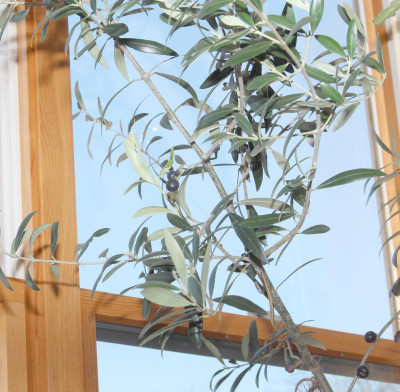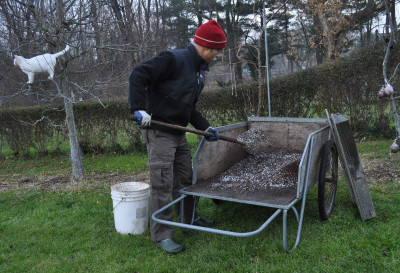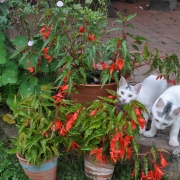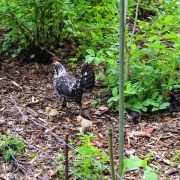OLIVE HARVEST IN FULL SWING HERE
What To Do With This Year’s Harvest?
Olive harvest will begin — and end — here this week. Yes, it’s late. After all, the harvest in Italy was in full swing weeks ago, back in autumn. But this is the Hudson Valley, in New York. What do you expect?
I’m talking about harvesting real olives, not Russian olives (Elaeagnus angustifolia) or autumn olive (E. umbellata), both of which grow extensively in a lot of places, including here. Too extensively, according to some people, which is why they’re listed as “invasives” and banned from being planted in some regions. (But their fruits are very tasty, their flowers are very fragrant, their leaves are very ornamental, and their roots enrich the soil with nitrogen from the air, all of which garnered them a chapter in my book Uncommon Fruits for Every Garden.)
Present harvest here is of the true olive (Olea europaea), unrelated to the previously mentioned olives. Temperatures in the Hudson Valley, and beyond, would spell death to an olive tree, which is cold-hardy to about 14°F, so my tree is planted in a pot, just like my other Mediterranean-climate plants — fig, pomegranate, feijoa, black mulberry, bay laurel, kumquat, black mulberry, and Golden Nugget mandarin (tangerine). I can handle only so many potted, small trees, so it’s lucky that my olive doesn’t need a mate to bear fruit; it’s the self-fruitful variety Arbequina. The plant I got a few years ago from Raintree Nursery started bearing its first season!
Unlike my fig, pomegranate, and mulberry, olive is evergreen, so it needs light year ‘round. Fig, and company, are in a dark corner of my cold basement, dormant. The olive is in a cool room basking in sunlight from a south-facing window.
Two years ago, after an auspicious start, only one olive remained on the tree in late summer. I think my duck ate it.
This past fall, the harvest has increased many-fold — to almost a dozen fruits. What with being knocked around when moved indoors and the change in environment, about half that number of fruits now hang from the branches.
I like my olives fully ripe, black, so have let them hang as long as possible. Some are beginning to dry and shrivel, so it’s time to harvest. Fresh, the fruits are unpalatable, with a bitterness that comes from oleuropein. That bitterness is removed by curing and fermentation using lye, salt, and time. I’ve had naturally cured olives that use only the last ingredient, time, and that’s how I’m going to try mine.
For More Than Just Olive Fruits
A few years ago, I almost got rid of my olive tree. After all, it wasn’t making a dent in my olive consumption. Then someone pointed out that the olive, for thousands of years, has been a symbol of peace. That alone should be enough reason to keep the tree, and it was.
Also, the tree is pretty and long-lived — thousands of years, as documented by radiocarbon dating.
Secret Soil Recipe, Divulged (Again)
In preparation for the upcoming gardening season, I brought pails of frozen potting soil, compost, and soil in from the garage/barn. Soon I’ll need to trim back roots and repot some of those Mediterranean-climate fruits, including my Arbequina olive. Not my Meiwa kumquat, though, some of whose green fruits are showing hints of yellow, foreshadowing ripening to begin over the next couple of months. Trimming back its roots would cause branches to let go of fruits.
Potting soil will also be needed for the first seeds of the season, to be sown indoors in the next week or so.
 I will now divulge my recipe for potting soil. The main ingredients are garden soil, compost, peat moss, and perlite. I thoroughly mix together equal volumes of these four ingredients, then add a cup of soybean or alfalfa meal (for extra nitrogen). If I’m feeling generous, I also throw in a half a cup or so of kelp meal (for micronutrients, although it’s probably superfluous with the panoply of nutrients from the compost). Perhaps also a half a cup of dolomitic limestone (for alkalinity, calcium, and magnesium, also probably superfluous with the buffering action and richness of the compost). Using wooden frames onto which I’ve stapled 1/2 inch hardware cloth, I sift together the mixture.
I will now divulge my recipe for potting soil. The main ingredients are garden soil, compost, peat moss, and perlite. I thoroughly mix together equal volumes of these four ingredients, then add a cup of soybean or alfalfa meal (for extra nitrogen). If I’m feeling generous, I also throw in a half a cup or so of kelp meal (for micronutrients, although it’s probably superfluous with the panoply of nutrients from the compost). Perhaps also a half a cup of dolomitic limestone (for alkalinity, calcium, and magnesium, also probably superfluous with the buffering action and richness of the compost). Using wooden frames onto which I’ve stapled 1/2 inch hardware cloth, I sift together the mixture.
Ten gallons of potting soil should carry me through winter until the compost piles and the soil have defrosted.
Olive Curing Update

Olives harvested and cured.
It’s now some days after I first wrote the above. Olives received no other treatment except being left to dry and wrinkle. Tasted them today — delicious! (I’m going to plan for bigger harvests for the future.)




still have the Meyer Lemon tree? didn’t see it on the list
A number of plants aren’t on the list. I still have Meyer, a few of them.
Looks like your cat is scoping out what to prune in that tree, in your soil mixing pic 🙂
Yes, my cat offers guidance on pruning.
Hi Lee… Sounds wonderful. Curious as to what size pots your small trees do well in?
Lugging things indoors and back out are challengingi!
My biggest pots are probably 18-20″ in diameter.
This is what I always wonder about potting soil recipes that call for “garden soil”: where do you get the garden soil? Do you rob it from your vegetable garden? Do you order it in? (Considering what I’ve read over time on this blog, I think not.) I always feel like I don’t have enough good garden soil as it is, and just can’t imagine taking some from the garden to make my own potting mix. And the native soil is heavy clay. Don’t think that’s what I want for a potting mix. And even if I did, there would be a hole left where I took it from, and I’d have to do something to keep the hole from being a hazard.
Excellent question. I get garden soil in various places. I have a soil bin where I dump excess soil if I’m excavating it from somewhere. Sometimes I’ll just skim off a layer of soil from where I just finished emptying a compost bin. One time I thought I would dig a pond (very slowly) by hand. I’ve never actually dug a hole just to get soil. The amount of soil I need is really very little — it only makes up 1/4 of my potting mixes. Even a clayey soil (that’s what I got to when digging my pond, which never materialized) is okay; clays have many benefits, especially when mixed with plenty of organic matter, such as in a potting mix.
I always appreciate your articles but they are made even better by “real” photos – like the one of you digging with a random cat in the background. Love it.